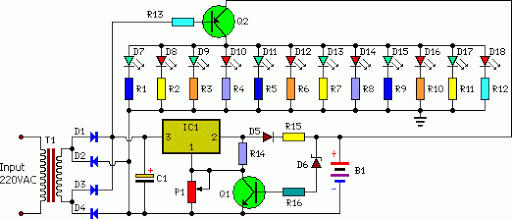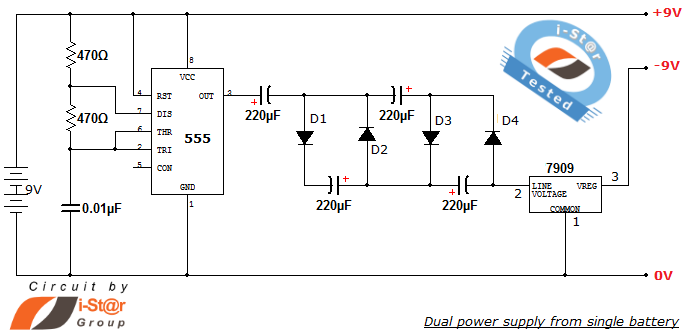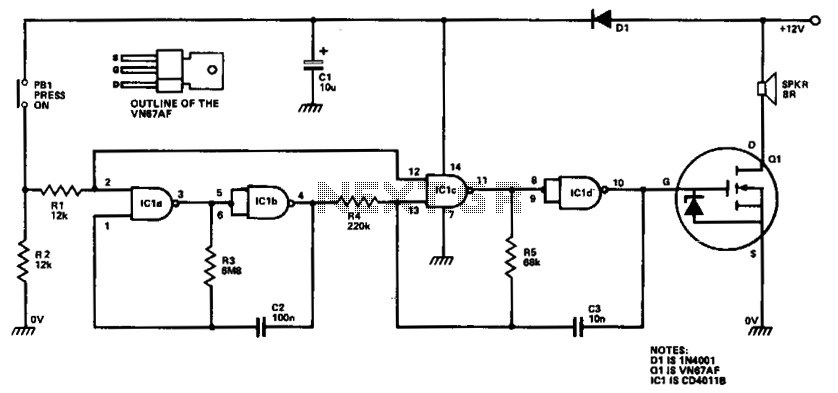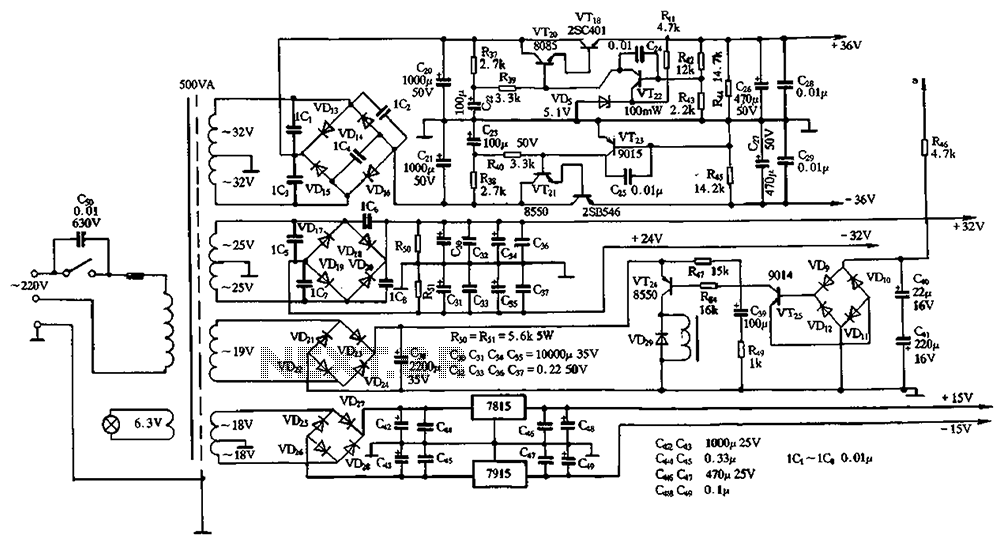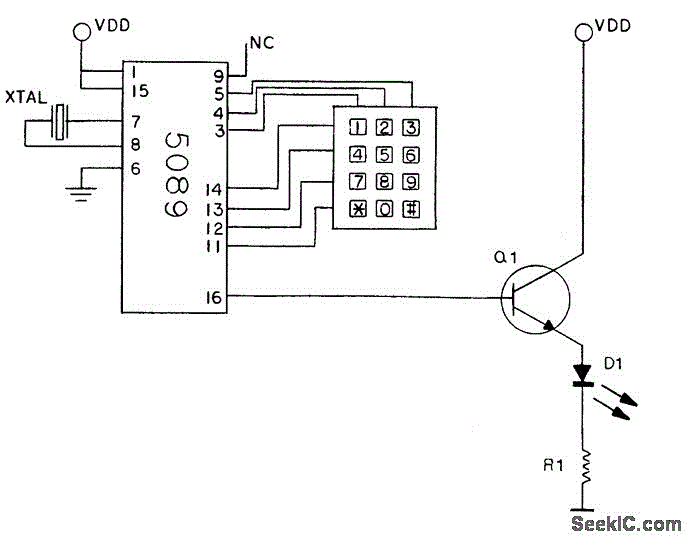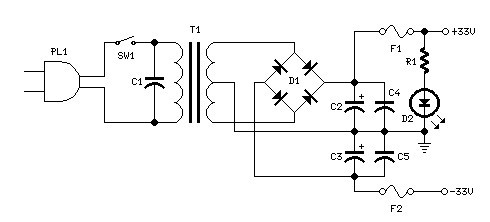
FM Wireless Microphone Transmitter with High Power
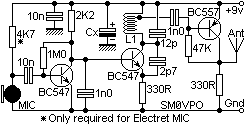
The FM Wireless Microphone has gained popularity among both beginners and experienced constructors. It has been utilized in guitars and as a component of remote control systems. There have been numerous requests for a higher-powered circuit with improved microphone sensitivity. The new FM Wireless Microphone (v5) features better frequency stability, a range exceeding 1 km (under ideal conditions), and enhanced microphone sensitivity. This enhancement is made possible by incorporating an RF amplifier buffer with a 10 dB gain and an audio frequency (AF) preamplifier to slightly boost modulation. The construction process is relatively straightforward. The inductor L1 consists of 3.25 turns in a spiral form and is an integral part of the PCB foil pattern. The two BC547 transistors can be substituted with nearly any small-signal NPN transistor, such as the 2N2222. The final stage employs a BC557 PNP general-purpose transistor. When using different devices, it is necessary to select the 1 MΩ resistor for a 5-volt DC at the collector of the first transistor and the 47 kΩ resistor for 3-4 volts at the collector of the third transistor. A modification is noted: previously, a 1 nF 5 mm capacitor was used for supply decoupling; however, a change in the component supplier led to RF instability when the gain of the power amplifier transistor exceeded normal levels. Replacing the 1 nF capacitor with a 22 µF electrolytic capacitor resolved this issue entirely. Any radial type electrolytic capacitor from 0.47 µF upwards will suffice. The finished unit consumes approximately 30 mA, which varies when the tuned circuit is touched, serving as a good test for oscillation. The 4.7 kΩ resistor should be removed if a dynamic microphone is used. The PCB dimensions are 50 mm x 25 mm, slightly larger than the original version, but it includes three stages instead of just one. The output power is about +10 dBm, representing an increase of approximately 10 dB compared to the first FM Wireless Microphone, theoretically extending the range to 1.6 km. However, testing was conducted indoors using a handheld receiver with the transmitter placed on a bench, achieving a comfortable range of 700 meters. Additionally, a "gimmick" capacitor has been added across the 12 pF tuning capacitor to lower the transmitter frequency. This capacitor can be created by twisting two lengths of single-core insulated hook-up wire, approximately 2 cm long. Adjusting the length of the gimmick capacitor will allow for tuning the frequency to the desired final value.
The FM Wireless Microphone (v5) circuit design emphasizes simplicity and adaptability, making it an excellent project for hobbyists. The RF amplifier buffer enhances the transmission power, significantly increasing the operational range. The choice of transistors, such as the BC547 and BC557, ensures compatibility with various small-signal applications, enabling easy substitutions based on availability. The inclusion of an AF preamplifier is crucial for improving the microphone sensitivity, allowing for clearer audio capture.
The PCB layout is designed to accommodate the components efficiently, with a focus on minimizing interference and maximizing performance. The spiral inductor L1 not only serves as a critical component for RF transmission but also integrates seamlessly into the PCB design, optimizing space and reducing the need for additional components.
The modification involving the electrolytic capacitor addresses potential stability issues, showcasing the importance of component selection in RF applications. The flexibility in choosing capacitors and resistors allows for fine-tuning the circuit to meet specific requirements, such as varying power supply voltages or adapting to different microphones.
The overall design of the FM Wireless Microphone (v5) reflects a balance between performance and ease of construction, making it suitable for a wide range of applications, from musical instruments to remote control systems. The ability to achieve a significant operational range while maintaining simplicity in design ensures its appeal to both novice and experienced electronics enthusiasts.FM Wireless Microphone has been a very popular project with beginners and experienced constructors alike. It has been used inside guitars and as the basis of a remote control system. I do however, receive many requests for a higher powered circuit and better microphone sensitivity. Now I can introduce the new FM Wireless Microphone (v5), which als o has a better frequency stability, over 1Km range (under ideal conditions) and is good on microphone sensitivity. This has been achieved by adding an RF amplifier buffer (with 10dB gain) and an AF preamplifier to boost the modulation a little.
Construction is quite simple. L1 is 3. 25 turns in spiral form and is an integral part of the PCB foil pattern. The two BC547 transistors can be replaced with (almost) any small-signal NPN transistor, such as the 2N2222. The final stage is a BC557 PNP general purpose device. If you use different devices then you should select the 1M0 resistor for 5-volts DC at the collector of the the first transistor.
Select the 47K resistor for 3 - 4 volts on the collector of the third transistor. Here is the V5 component overlay drawing. Note that there is a modification: There used to be a 1n0 5mm cap for supply decoupling, but after a cange of component supplier (manufacturer ) there developed some form of RF instability when the gain of the PA transistor was a little above normal. Replacing the 1n0 to an electrolytic capacitor of 22uf cured this problem totally. Any "radial" (the leads both come out of the same end) type electrolytic capacitor from 0. 47uf upwards cures the problem. The finished unit draws about 30mA which should vary as you touch the tuned circuit, a good test that the unit is oscillating.
You should remove the 4K7 resistor if you use a dynamic microphone. The PCB is 50mm x 25mm, a little larger than the first version but there are three stages instead of just the one. The first prototype is shown above, beside the battery powering it. The output power is about +10dBm which is about 10dB more than the first FM Wireless Microphone. This would theoretically give it 3. 12 times the range (1. 6Km) but I have only tested it using a handheld receiver with the TX laying on the bench indoors. But I got a comfortable 700 meters (and a few funny looks from our neighbours). Above you can see the addition of a "gimmick" capacitor added across the 12p tuning capacitor to lower the frequency of the transmitter.
Make the capacitor by twisting two lengths of single core insulated hook-up wire, about 2cm long. This will reduce the frequency to the bottom end of the band. Cut short the capacitor to increase the frequency to the desired final frequency. If you cut it a few KHz too high then just twist the gimmick a little tighter. 🔗 External reference
The FM Wireless Microphone (v5) circuit design emphasizes simplicity and adaptability, making it an excellent project for hobbyists. The RF amplifier buffer enhances the transmission power, significantly increasing the operational range. The choice of transistors, such as the BC547 and BC557, ensures compatibility with various small-signal applications, enabling easy substitutions based on availability. The inclusion of an AF preamplifier is crucial for improving the microphone sensitivity, allowing for clearer audio capture.
The PCB layout is designed to accommodate the components efficiently, with a focus on minimizing interference and maximizing performance. The spiral inductor L1 not only serves as a critical component for RF transmission but also integrates seamlessly into the PCB design, optimizing space and reducing the need for additional components.
The modification involving the electrolytic capacitor addresses potential stability issues, showcasing the importance of component selection in RF applications. The flexibility in choosing capacitors and resistors allows for fine-tuning the circuit to meet specific requirements, such as varying power supply voltages or adapting to different microphones.
The overall design of the FM Wireless Microphone (v5) reflects a balance between performance and ease of construction, making it suitable for a wide range of applications, from musical instruments to remote control systems. The ability to achieve a significant operational range while maintaining simplicity in design ensures its appeal to both novice and experienced electronics enthusiasts.FM Wireless Microphone has been a very popular project with beginners and experienced constructors alike. It has been used inside guitars and as the basis of a remote control system. I do however, receive many requests for a higher powered circuit and better microphone sensitivity. Now I can introduce the new FM Wireless Microphone (v5), which als o has a better frequency stability, over 1Km range (under ideal conditions) and is good on microphone sensitivity. This has been achieved by adding an RF amplifier buffer (with 10dB gain) and an AF preamplifier to boost the modulation a little.
Construction is quite simple. L1 is 3. 25 turns in spiral form and is an integral part of the PCB foil pattern. The two BC547 transistors can be replaced with (almost) any small-signal NPN transistor, such as the 2N2222. The final stage is a BC557 PNP general purpose device. If you use different devices then you should select the 1M0 resistor for 5-volts DC at the collector of the the first transistor.
Select the 47K resistor for 3 - 4 volts on the collector of the third transistor. Here is the V5 component overlay drawing. Note that there is a modification: There used to be a 1n0 5mm cap for supply decoupling, but after a cange of component supplier (manufacturer ) there developed some form of RF instability when the gain of the PA transistor was a little above normal. Replacing the 1n0 to an electrolytic capacitor of 22uf cured this problem totally. Any "radial" (the leads both come out of the same end) type electrolytic capacitor from 0. 47uf upwards cures the problem. The finished unit draws about 30mA which should vary as you touch the tuned circuit, a good test that the unit is oscillating.
You should remove the 4K7 resistor if you use a dynamic microphone. The PCB is 50mm x 25mm, a little larger than the first version but there are three stages instead of just the one. The first prototype is shown above, beside the battery powering it. The output power is about +10dBm which is about 10dB more than the first FM Wireless Microphone. This would theoretically give it 3. 12 times the range (1. 6Km) but I have only tested it using a handheld receiver with the TX laying on the bench indoors. But I got a comfortable 700 meters (and a few funny looks from our neighbours). Above you can see the addition of a "gimmick" capacitor added across the 12p tuning capacitor to lower the frequency of the transmitter.
Make the capacitor by twisting two lengths of single core insulated hook-up wire, about 2cm long. This will reduce the frequency to the bottom end of the band. Cut short the capacitor to increase the frequency to the desired final frequency. If you cut it a few KHz too high then just twist the gimmick a little tighter. 🔗 External reference
